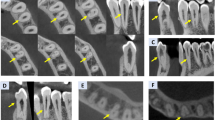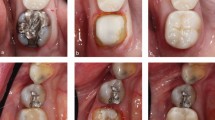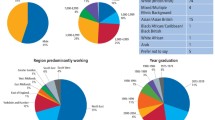Abstract
Objective To investigate variations in tooth preparations for resin-bonded all-ceramic crowns (RBCs) in general dental practice (GDP).
Design Laboratory-based retrospective analysis of dies for RBCs.
Setting General dental practices in the UK and Ireland (2000).
Methods A sample (n = 132) of laboratory models containing 180 tooth preparations for RBCs, featuring work from different general dental practitioners was obtained from four commercial dental laboratories. Aspects of the preparations were quantified and compared with accepted criteria defined following a review of the literature.
Results The teeth found to be most frequently prepared for RBCs were maxillary incisors (41%). Margin positions were variably positioned with 29% of the preparations on the buccal aspect having subgingival margins. There were many tooth preparation dies for low fusing RBCs (47%) and Chameleon Fortress RBCs (62%) demonstrating overpreparation in the mesiodistal plane. The majority of the margins (84% buccally and 79% lingually) of the dies examined exhibited appropriate shoulder or chamfer finishes. Of the Chameleon Fortress preparations analysed, 86% had been underprepared occlusally. 42% of the teeth had been prepared with no regard to tooth morphology and demonstrated just one plane of reduction. The majority (93%) of the clinicians failed to provide any information regarding the shade of the prepared tooth stump.
Conclusions On the evidence of this survey of this sample of general dental practitioners' work, it was found that relevant guidelines for the preparations of RBCs are not being fully adhered to.
Similar content being viewed by others
Log in or create a free account to read this content
Gain free access to this article, as well as selected content from this journal and more on nature.com
or
References
Bowen R L . Adhesive bonding of various materials to hard tooth tissues. Part 2: bonding to dentin promoted surface-active comonomer. J Dent Res 1965; 44: 895–902.
Rezinkor H . The dentin bonded porcelain crown. In: Clinical procedures manual. Cedar Rapids: Dental Prosthetic Services Inc., 1987.
Crothers A J R, Wassell R W, Allen P F . The resin-bonded porcelain crown: A rationale for use on anterior teeth. Dent Update 1993; 20: 388–395.
Burke F J T, Qualtrough A J E, Hale R W . Dentine-bonded all-ceramic crowns: current status. J Am Dent Assoc 1998; 129: 455–460.
Burke F J T, Watts D C . Fracture resistance of teeth restored with dentin-bonded crowns. Quintessence Int 1994; 25: 335–340.
Cassidy M, McLaughlin W S, Grey N J . Aesthetics and porcelain veneers. Restorative Dent 1989; 5: 42–45.
Chameleon Dental Products. Fortress Information Leaflet. Kansas City, Kan, USA. Chameleon Dental Products.
Ivoclar-Vivadent. IPS Empress Information Leaflet. Schaan, Liechtenstein: Ivoclar-Vivadent.
Burke F J T . The effect of variations in bonding procedure on fracture resistance of dentin-bonded all-ceramic crowns. Quintessence Int 1995; 26: 293–300.
Brunton P A, Wilson N H F . Preparations for porcelain laminate veneers in general dental practice. Br Dent J 1998; 184: 553–556.
Mayers R E et al. Standards of Human Occlusal Development. Center for Human Growth and Development — The university of Michigan, 1976; 45–48.
Etemadi S, Smales R J, Drummond P W, Goodhart J R . Assessment of tooth preparation designs for posterior resin-bonded porcelain restorations. J Oral Rehabilitation 1999; 26: 691–697.
Strohaver R A . A comparison of articulator mountings made with centric relation and myocentric position records. J Prosthet Dent 1972; 28: 379–390.
Landis J R, Koch G C . The measurement of observer agreement for categorical data. Biometrics 1977; 33: 159–174.
Smith P W, Richmond R, McCord J F M . The design and use of special trays in prosthodontics: guidelines to improve clinical effectiveness. Br Dent J 1999; 187: 423–426.
Winstanley R B, Carrotte P V, Johnston A . The quality of impressions for crowns and bridges received at commercial dental laboratories. Br Dent J 1997; 184: 209–213.
Shillingburg H T, Hobo S, Whitsett L D . Fundamentals of fixed prosthodontics. 3rd ed. Chicago: Quintessence Publishing Co. 1997.
Karlsson S, Landah I, Stegersjo G, Milleding P A . A clinical evaluation of porcelain laminate veneers. Int J Prosthodont 1992; 5: 447–451.
Lacy A M, Wada C, Du W, Watanabe L . In-vitro microleakage at the gingival margin of porcelain and resin veneers. J Prosthet Dent 1992; 67: 7–10.
Sim C, Neo J, Chua E K, Tan B Y . The effect of dentine bonding agents on the microleakage of porcelain veneers. Dent Mater 1994; 10: 278–281.
Preston J D . Rational approach to tooth for ceramo-metal restorations. J Prosthet Dent 1977; 21: 683–698.
Saunders W P, Saunders E M . Prevalence of periradicular periodontitis associated with crowned teeth in an adult Scottish subpopulation. Br Dent J 1998; 185: 137–140.
Christensen G J . Tooth preparation and pulp degeneration. J Am Dent Assoc 1997; 128: 353–354.
Burke F J T . Maximising the fracture resistance of dentine-bonded all-ceramic crowns. J Dent 1999; 27: 169–173.
Broderson S P . Complete-crown and partial tooth preparation designs for bonded cast ceramic restorations. Quintessence Int 1994; 25: 535–539.
Rimmer S E, Mellor A C . Patient's perceptions of aesthetics and technical qualities of crowns and fixed partial dentures. Quintessence Int 1996; 27: 155–162.
Author information
Authors and Affiliations
Corresponding author
Additional information
Refereed Paper
Rights and permissions
About this article
Cite this article
Sutton, A., McCord, J. Variations in tooth preparations for resin-bonded all-ceramic crowns in general dental practice. Br Dent J 191, 677–681 (2001). https://doi.org/10.1038/sj.bdj.4801268
Received:
Accepted:
Published:
Issue date:
DOI: https://doi.org/10.1038/sj.bdj.4801268



